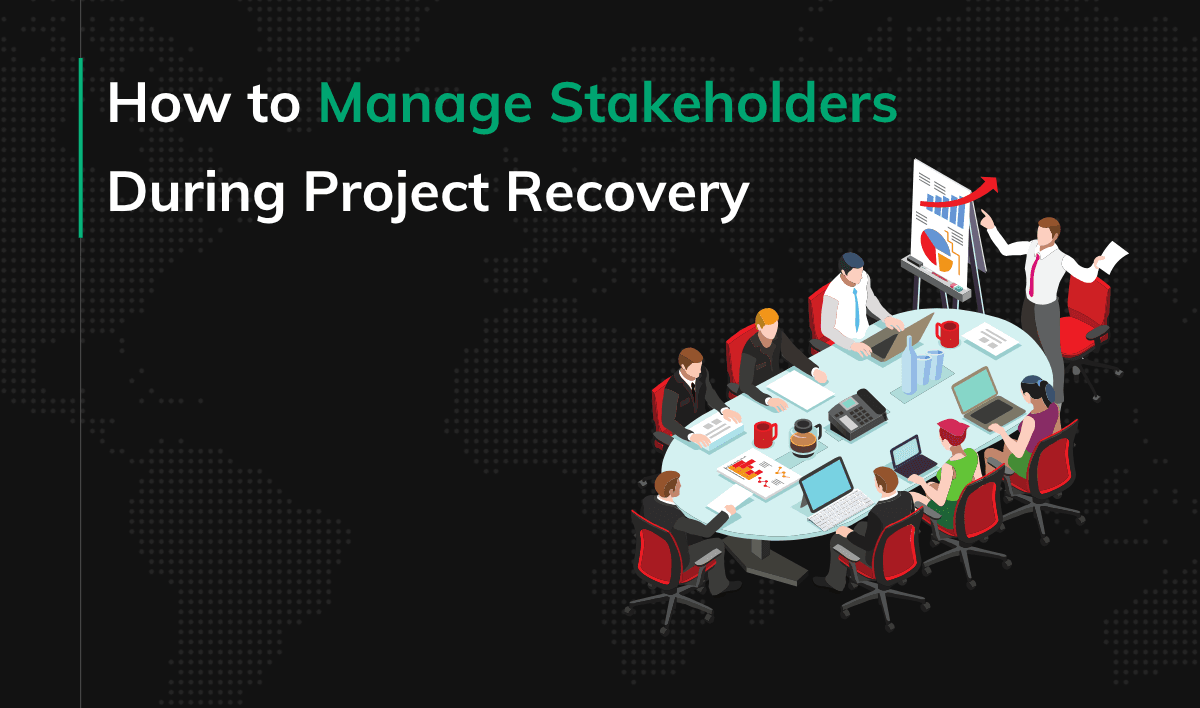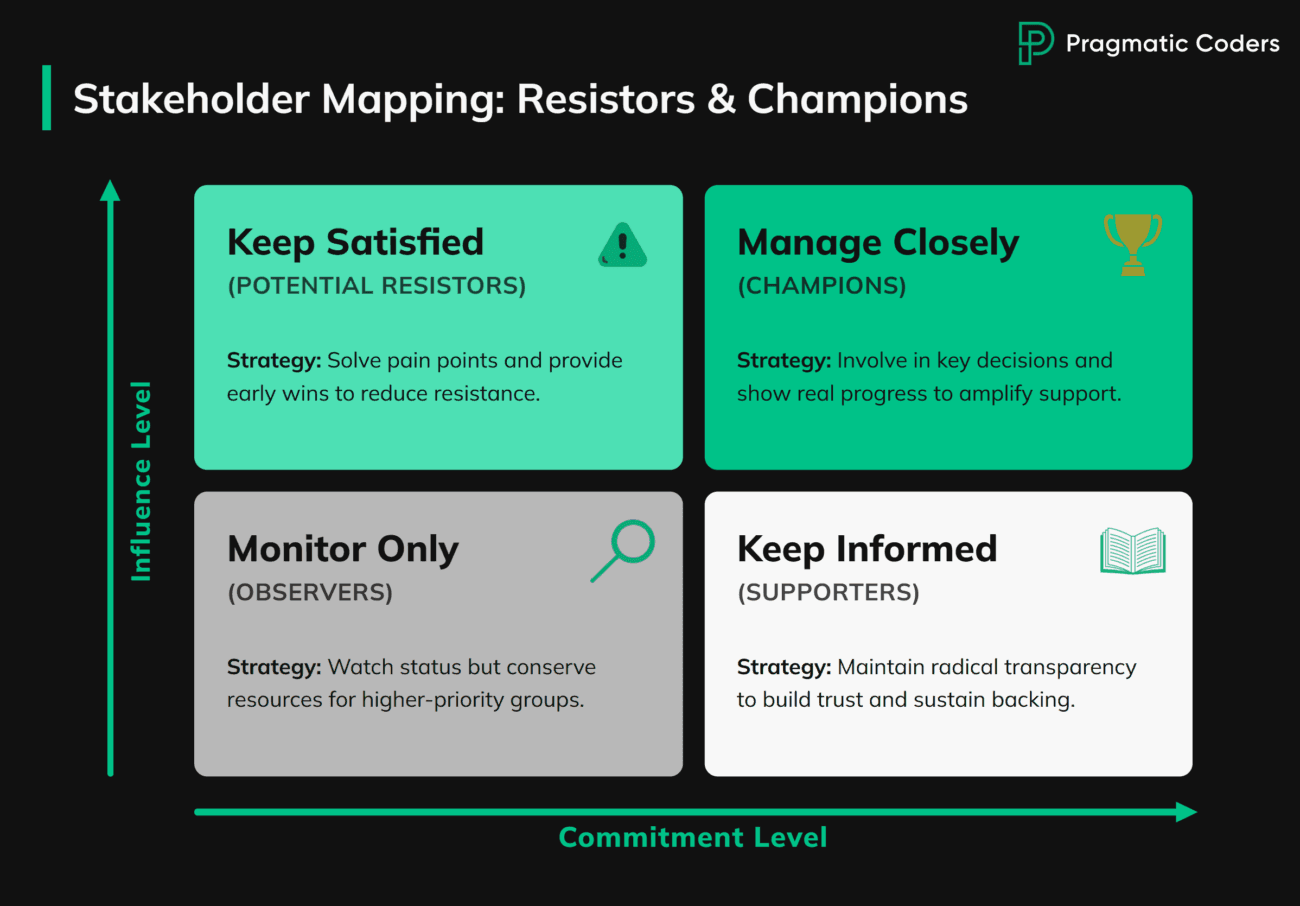How to Manage Stakeholders During Project Recovery

Inadequate communication is a primary cause of project failure for 29% of projects. When a software project crashes and a new team takes over, stakeholders aren’t just skeptical. They’re burned, anxious, and actively resistant to trusting another vendor. The budget is bleeding. Market share may be slipping. Someone’s reputation is on the line. This is not standard project management.
Managing stakeholders during a project rescue requires a fundamentally different approach. You’re not managing expectations around a healthy roadmap. You’re managing a crisis where trust has evaporated, emotions run high, and every technical decision can become a political battle. This article walks through the proven strategies for moving stakeholders from chaos to control, following the rescue lifecycle chronologically from first contact to sustainable partnership.
Key Points
|
Stabilize Stakeholder Emotions Before You Execute Your Project Recovery Plan
Stakeholders arrive burned and skeptical. Your first goal is emotional stabilization, not feature delivery. Skip this step, and every technical decision becomes a battle.
Understand the Emotional Landscape
The context matters. The previous vendor failed. The budget is bleeding. Market share may be at risk. Stakeholders are emotionally invested in the failure narrative. Some may feel personally responsible for choosing the failed vendor. That anxiety manifests in predictable ways: micromanagement, resistance to your recommendations, or withdrawal from the process entirely.
You need to normalize their experience with data. Large IT projects run 56% over budget and 33% over time while delivering 56% less value than planned. One in six becomes a black swan with an average of 200% cost overruns. The message: you’re not alone in this. The odds were stacked against the last team. They were wrestling with systemic complexity that most teams underestimate.
Prioritize Stakeholder Trust
Your first priority is stabilizing emotions and stopping the bleeding, not shipping features. You must earn trust through competence before you can execute any roadmap. Initial conversations focus on demonstrating understanding, not defending timelines.
The strategy is empathy paired with professional firmness. Listen actively to their pain points without making excuses for your predecessor. Acknowledge stakes directly: “We understand you’re losing revenue every week this drags on.” Set immediate expectations: “Our first job is assessment, not coding. We need to understand what we’re working with before we can execute effectively.”
Avoid corporate speak. Clients in crisis need directness, not polish. Lead with honesty about both problems and timelines. That candor in the first conversation builds more trust than any polished pitch deck. This approach has been tried and tested across multiple of our recovery engagements.
Use the Project Takeover Audit to Reset Expectations
Run a thorough project takeover audit to understand what you’re actually dealing with. Concrete data should be your foundation for every stakeholder conversation.
Data Over Project Drama
The audit moves the conversation from subjective blame to objective reality. No more “Why isn’t it done?” Instead: “Here’s the technical debt blocking us.” Audit findings become the shared truth that everyone operates from. No more “he said, she said” about why the project failed. The codebase speaks for itself.
Using the Audit as a Strategic Tool
You cannot manage stakeholders with guesses. At Pragmatic Coders, we begin every software rescue with a deep-dive audit. This gives us the cold, hard data needed to have honest conversations about why the previous setup failed and exactly how we can fix it.
The audit covers codebase quality, architecture patterns, technical debt accumulation, security vulnerabilities, and IP control. The deliverable is a written assessment that stakeholders can reference when questions arise. Timeline is usually one to two weeks, depending on complexity. That might feel slow when the pressure is on, but guessing wrong costs more.
Regaining IP Control and Stakeholder Confidence
The audit reassures stakeholders that they own their code again. Many rescues involve IP hostage situations or unclear code ownership. Documented findings prove you have full access and control. This creates a psychological reset: the old chapter is closed, and a new chapter begins with clarity.
The audit also becomes your defense against unrealistic expectations later. When stakeholders push for impossible deadlines, you point back to the documented findings. “We found 47 critical bugs and 5% test coverage. That’s why the old timeline was fiction.” Data ends arguments that emotion prolongs.
Map Your Stakeholders
Not all stakeholders are equally invested in the rescue. Identifying resistors and champions early lets you neutralize blockers and amplify supporters before they derail progress.
Takeovers create internal political tension. The person who hired the failed vendor may feel defensive. Internal team members may be invested in defending legacy decisions. Budget holders may be skeptical of giving “one more chance” to yet another vendor. You need to map this landscape fast.

Use an influence and commitment matrix to categorize stakeholders into four quadrants: Monitor Only, Keep Satisfied, Keep Informed, and Manage Closely. The goal is smart resource allocation. You can’t give everyone equal attention in a crisis.
Identify Potential Resistors
Look for stakeholders defending the status quo despite obvious failures. Common profiles include the original vendor advocate who doesn’t want to admit their mistake, the technical lead emotionally attached to legacy architecture, and the exec who sees your arrival as implicit critique of their oversight.
Your strategy is winning them over by solving their pain points. Don’t argue about the past. Focus on their current problems. Give them early wins that make them look good internally. Turn resistors into champions by making them part of the solution. When they can claim credit for the turnaround, resistance evaporates.
Identify Champions
Champions need to see immediate results to keep the budget open. Look for stakeholders who are directly impacted by project failure through revenue loss or reputation risk. Look for those with authority to unblock decisions quickly. Look for people frustrated with the previous lack of transparency.
Your strategy is moving people from “Monitor Only” to “Champions” by showing competence. Give them visibility into real progress. Involve them in key decisions early so they feel ownership. A champion in the C-suite is worth ten neutral stakeholders in middle management.
Rebaseline the Roadmap in Project Recovery (Even When It Hurts)
Stakeholders want to keep the original deadline alive. Your job is killing that fantasy with data and proposing a realistic path forward that mixes technical repair with visible wins.
Confronting Unrealistic Expectations
The challenge is navigating three psychological barriers. First, the sunk cost fallacy: “We’ve already spent so much, we can’t delay further.” Second, public commitments: stakeholders may have promised dates to the board, customers, or investors. Third, emotional resistance: admitting timeline failure feels like personal failure.
You need to confront these directly. Show audit findings that make the old timeline impossible. Use specific data: “The current test coverage is just 5%. That’s why every new feature takes three times longer than estimated.”
Present the Takeover Plan
Propose a new baseline with clear phases. Phase one is stabilization: fix critical issues, establish CI/CD, regain IP control. Phase two is repair: pay down technical debt while delivering small wins. Phase three is growth: accelerate feature development with a solid foundation. Be specific about what’s possible in what timeframe. Vague promises destroy the credibility you’re trying to build.
Differentiate Alignment from Agreement
They may not like the delay, but they must understand why it’s necessary. Alignment means: “I see why this is the reality, even if I wish it weren’t.” That’s different from agreement. Get explicit sign-off on the new baseline to prevent future “but you promised” conversations. Document it. Email it. Reference it in every status update.
Mixing Debt Payoff with Business Value
Build a backlog that alternates technical debt work with visible progress. Sprint one: fix CI/CD plus ship one customer-facing bug fix. Sprint two: refactor the auth system, plus add one small feature. Stakeholders see movement immediately, even during the repair phase.
This approach acknowledges reality while maintaining momentum. Pure technical debt work for three months kills stakeholder patience. Pure feature work on a broken foundation creates more problems than it solves. The mix keeps stakeholders satisfied while you systematically address the underlying issues.
Build Stakeholder Trust Through Radical Transparency
Showing stakeholders exactly what you see builds trust faster than any polished status report.
The No-Surprises Rule
Bad news delivered early is better than bad news delivered late. Always. Watermelon reporting (green on the outside, red on the inside) destroys trust. The classic example: a project stuck at “90% complete” for months while it’s actually blocked. Rescue projects cannot afford this. Trust is too fragile.
Establish a norm from day one: problems are reported immediately with proposed solutions. Rather than saying “we hit a blocker,” you should say “we hit a blocker in the auth system. Here are three options to resolve it, with trade-offs for each.” This shifts the conversation from blame to collaboration.
Full Visibility into Tools
Give clients full access to everything you see. Share the same Jira backlog and burndown charts you use internally. Provide complete visibility into code repositories, including commits, branches, and pull requests. Make test results and coverage metrics available. Show build status and deployment logs through CI/CD pipelines.
Why does this work? Because transparency removes suspicion and creates partnership. The common objection: “Won’t this overwhelm non-technical stakeholders?” The answer: they don’t need to read every commit, but knowing they could builds trust. It signals you have nothing to hide.
Definition of Done
Establish a shared understanding of what “done” means. Not “coded but not tested.” Not “works on my machine.” Done means coded, tested, documented, deployed to staging, and approved by the product owner. Stakeholders never have to guess if a feature is actually finished or just “mostly” finished. There’s no such thing as “definition of almost done”.
This governance prevents the erosion of standards under pressure. When stakeholders push for a rushed release, you point to the Definition of Done. “We agreed that nothing ships without automated tests. Do you want to change that agreement?” Usually, they don’t. They just needed the reminder.
Communication is project-critical. The data backs this: inadequate communication is a primary cause of project failure for 29% of projects. This transparency strategy directly addresses the most common failure mode. For a deeper dive into stakeholder engagement strategies beyond crisis mode, see our guide about managing stakeholders.
Frame Technical Work as Business Wins for Stakeholders
Technical work means nothing to stakeholders unless you translate it into business impact. For example: unless you tell them how exactly their business will benefit from automated testing, they’ll just treat implementing it as a waste of valuable resources.
The Code-to-Business Translation Framework
There’s a gap between what stakeholders see and what engineers see. Stakeholders see “two sprints and no new features.” Engineers see “foundation stabilized, velocity will triple next month.” That gap creates frustration and distrust. Your job is closing it.
Translate every technical investment into business language. CI/CD means “release to market daily instead of monthly,” which translates to competitive advantage. Automated testing means “customers won’t find bugs before you do,” which translates to reputation protection. Observability means “know about issues before customers complain,” which translates to higher uptime. Refactoring means “future features take one week instead of three,” which translates to cost reduction.
Use analogies for non-technical stakeholders. Technical debt is like not changing your car’s oil. It seems fine until the engine seizes. CI/CD is like having a factory assembly line instead of hand-crafting each product. Automated tests are like a spell-checker that scans your entire document for logic errors. These metaphors aren’t perfect, but they’re comprehensible.
Evolve Your Stakeholder Engagement from Crisis to Partnership
Success means transitioning from firefighting to strategic partnership. When stakeholders stop asking “Can you deliver?” and start asking “What should we build next?”, the rescue is complete.
Recognize When the Fire Is Out
The crisis phase ends when specific indicators appear. No more emergency calls about production outages. Releases happen on schedule without drama. Stakeholders stop asking “Is it really fixed this time?” Velocity becomes predictable. The timeline varies, but typically ranges from three to six months, depending on the initial damage.
At this point, shift to standard engagement tactics. The intensity that served you during crisis mode becomes exhausting during normal operations.
Transition to Normal Project Cadence
Move to a sustainable rhythm. Hold regular demos to show progress and gather feedback. Include key stakeholders in sprint reviews. Keep them in the loop, but let them relax a little.
Measure Success by the Questions They Ask
A rescue succeeds when conversations shift from damage control budget discussions to growth investment planning, and from skepticism to advocacy. That shift signals you’ve crossed from rescue to partnership.
The goal is functional trust and working alignment, not universal love. Accept that some resistors stay resistors. That’s fine. Focus on building a critical mass of support. If you have the budget holder, the technical lead, and the CEO aligned, you can proceed despite objections from middle management.
Conclusion
Stakeholder management during a project rescue requires crisis leadership, not standard project management. The seven-phase journey moves chronologically through emotional stabilization, data-driven resets, political mapping, difficult rebaselining, radical transparency, business translation, and finally strategic partnership. The through-line connecting every phase: competence demonstrated through transparency builds trust faster than any promise.
Here’s the paradox of rescue projects. Stakeholders who emerge from successful recoveries are often more engaged and aligned than those who never experienced failure. Why? Because they’ve seen behind the curtain. They understand the complexity. They’ve participated in hard decisions under pressure. They’ve witnessed a team delivering on commitments against impossible odds.
If your project is in crisis and stakeholders have lost faith, start with an assessment before action. Understanding the true state of your codebase, IP position, and technical debt gives you the foundation to have honest conversations and build a realistic recovery plan. And if you need help navigating a project rescue, contact us!





